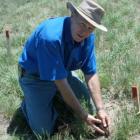
Get access to all handy features included in the IVIS website
- Get unlimited access to books, proceedings and journals.
- Get access to a global catalogue of meetings, on-site and online courses, webinars and educational videos.
- Bookmark your favorite articles in My Library for future reading.
- Save future meetings and courses in My Calendar and My e-Learning.
- Ask authors questions and read what others have to say.
Nicotiana species: Tobacco
Get access to all handy features included in the IVIS website
- Get unlimited access to books, proceedings and journals.
- Get access to a global catalogue of meetings, on-site and online courses, webinars and educational videos.
- Bookmark your favorite articles in My Library for future reading.
- Save future meetings and courses in My Calendar and My e-Learning.
- Ask authors questions and read what others have to say.
Read
Family
Cucurbitaceae
Common Name
Balsam pear, balsam apple, bitter gourd, bitter cucumber, balsamina. Two species are naturalized in North America; M. balsamina and M. charantia.
Plant Description
Comprising a genus of 35 - 40 species native to the tropical areas of Africa, Momordica species have become naturalized in tropical areas of North America.
The plants are vines, with slender, hairy, grooved, stems that may grow to 10 m in length. The leaves are simple, triangular, ovate or cordate, with 3 - 7 palmate lobes. Flowers are single, showy, yellow to orange in color, with 5 sepals and 5 petals. Fruits are up to 6 cm in length, pendulous, and covered with pointed, wart-like projections, turning yellow when ripe and splitting open to reveal numerous seeds with bright orange-red fleshy arils (Fig. 273).
Figure 273. Momordica charantia.
Toxic Principle and Mechanism of Action
Tetracyclic cucurbitane terpenoids (momordicin I,II), and at least 2 lectins are the toxins most responsible for the toxicity of the plant [1,2]. All parts of the plant are toxic with the exception of the fleshy ripe arils covering the seeds [3]. The compounds act as gastrointestinal irritants and in high doses may cause depression, muscle tremors, and seizures. Similar cucurbitane compounds are found in bryony (Bryonia spp.) and buffalo gourd (Cucurbita foetidissima), species of which are native to North America. Mormordica species have found wide use in herbal remedies and may have benefit in treating certain cancers [4].
Risk Assessment
Since fruits and seeds are attractive to some birds, the plant seeds are quite easily spread. The brightly colored fruits and seeds are also attractive to children and to pets especially where the vines are grown in gardens and along fences. Momordica poisoning is not frequently reported in dogs except in Florida where several instances of poisoning have occurred [3].
Clinical Signs
Vomiting, salivation, abdominal pain, and diarrhea are the most likely signs associated with Mormordica. Dogs that eat the ripe fruits reportedly develop convulsions and vomiting [3].
Severely affected animals may require sedation and intravenous fluid therapy to counteract dehydration and shock following severe diarrhea and vomiting.
Get access to all handy features included in the IVIS website
- Get unlimited access to books, proceedings and journals.
- Get access to a global catalogue of meetings, on-site and online courses, webinars and educational videos.
- Bookmark your favorite articles in My Library for future reading.
- Save future meetings and courses in My Calendar and My e-Learning.
- Ask authors questions and read what others have to say.
1. Connolly JD, Hill RA. Dictionary of Terpenoids. Vol 2. Di- and higher terpenoids. Chapman & Hall, London 1173-1180, 1991.
2. Lin J-Y, Hou M-J, ChenY-C. Isolation of toxic and non-toxic lectins from the bitter-pear melon Momordica charantia. Linn. Toxicon 653-660, 1978.
3. Morton JF. Plants Poisonous to People in Florida. 2nd ed. JF Morton ed. Southeastern Printing, Stuart, Florida. 73-74, 1982.
...About
How to reference this publication (Harvard system)?
Affiliation of the authors at the time of publication
Department of Clinical Sciences, College of Veterinary Medicine and Biomedical Sciences, Colorado State University, Fort Collins, CO, USA.
Author(s)
Copyright Statement
© All text and images in this publication are copyright protected and cannot be reproduced or copied in any way.Related Content
Readers also viewed these publications
Buy this book
Buy this book
This book and many other titles are available from Teton Newmedia, your premier source for Veterinary Medicine books. To better serve you, the Teton NewMedia titles are now also available through CRC Press. Teton NewMedia is committed to providing alternative, interactive content including print, CD-ROM, web-based applications and eBooks.
Teton NewMedia
PO Box 4833
Jackson, WY 83001
307.734.0441
Email: sales@tetonnm.com




Comments (0)
Ask the author
0 comments